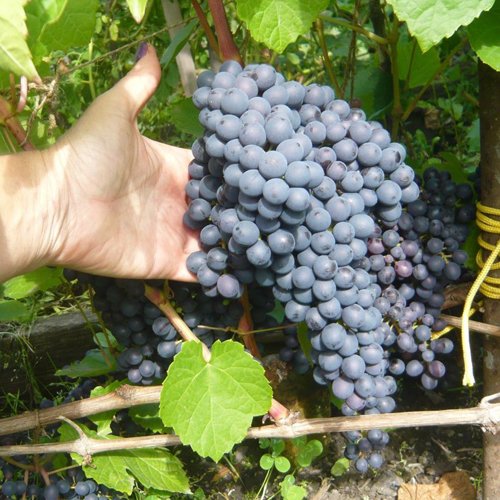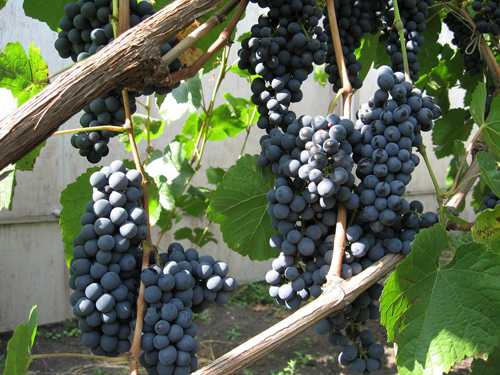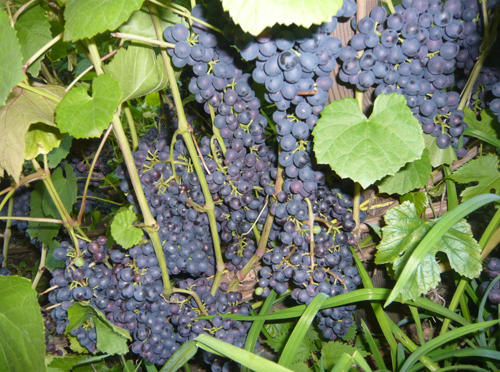Grape variety in Memory of Dombkovskaya
In memory of Dombkovskaya - unique in its characteristics seedless grape variety of domestic selection. It was bred in 1983 at the Orenburg support point for northern viticulture VNIIViV, which has now been transformed into the Experimental Station of Horticulture and Viticulture VSTISP RAAS. The author of the novelty is the famous enthusiast of the northern grape culture Fedor Shatilov. Fyodor Ilyich began his research activity on a personal plot, but his experience attracted prominent world-renowned scientists so much that with their help, a Stronghold was established, which Shatilov headed from 1963 to 1988.

The varieties Zarya Severa and Kishmish unique were used as a parental pair for hybridization. As a result of the crossing, a magnificent kishmish hybrid was obtained, which inherited only their best qualities from their parents: giant and stable yield, lack of seeds in berries, high sugar accumulation and excellent indicators of vine resistance to frost. Thanks to all this, the variety quickly gained popularity among amateur winegrowers in the Urals, Siberia and the north of the European part of the country. At the beginning of the 2000s, the hybrid form passed the state variety test and was included in the State Register of Breeding Achievements of the Russian Federation. The name of the grape is dedicated to Yanina Adamovna Dombkovskaya, the famous researcher and colleague of Fyodor Ilyich.
For the sake of fairness and completeness, it should be noted that there is an opinion that the direct author of the variety is not Shatilov, but an unknown winegrower who handed over the seedlings with the name BCHZ (seedless black winter-hardy) at the All-Union seminar on northern viticulture, held in Orenburg in 1980. Supporters of this version argue that Shatilov did not directly participate in crossing, but only improved the variety by clonal selection. But be that as it may, the merits of Fyodor Ilyich in the popularization of the magnificent hybrid should be recognized, because without this Memory, Dombkovskaya could well have remained an unknown form to anyone on someone's garden plot.
Agrobiological characteristics
The bushes are characterized by very strong growth. Leaves of medium size and dissection, rounded, consist of three or five lobes curving upward. The front side is dark green, finely bubbly, the back is covered with weak cobweb pubescence. The upper lateral notches are shallow, slit-like or in the form of a reentrant angle; the lower ones are most often absent, but may be barely marked. Petiole notches are mostly open, lyre-shaped with a rounded bottom, less often slit-like or closed with an ovoid lumen. Petioles are long, light green in color, sometimes with reddish pigmentation. The denticles along the edge of the leaf blade are low, dome-shaped. The flowers are bisexual, which ensures excellent fruit set. Only in some cases, associated with unfavorable flowering conditions, or deficiencies in care, berries can show noticeable peas. The vine ripens in any climatic conditions, where the grapes have time to ripen, and this happens for the entire length of the shoot, after which it changes color to brown.

The bunches of the variety grow not too large, 18-26 cm long, 10-17 cm wide and with an average weight of 350-400 grams. The best ones reach a weight of 1 kg. Their shape is cylindrical-conical, sometimes winged, the density is medium, or rather high. In dense clusters, the grapes may be somewhat deformed due to the strong adherence to each other. The combs are short, herbaceous, of weak green color. Berries of Memory of Dombkowska are medium, round, almost black, covered with a thick layer of protective wax coating, 12-16 mm in diameter and weighing up to 4-5 grams.The pulp is colored, tender and juicy, with a pleasant varietal taste, often with a slight sourness. Freshly squeezed juice of dark pink or burgundy color, has both high sugar content - 19-21 g / 100 ml, and not the lowest acidity that can be tipped - 8-9 g / l. Its output reaches 70-75% of the total weight of the crop. The skin of the berries is thin, bursting in the mouth and almost imperceptible when chewed. Seeds are absent, due to which the grapes are classified as seedless class IV. This to some extent raises the tasting characteristics of the berries, which were estimated at 7 points during the state variety testing.
Harvest in Memory of Dombkowska can be considered universal in the direction of use. What his fans do not do with him. It goes without saying that seedless crops are popular fresh. Of course, our hero cannot be attributed to the market varieties, but he is quite suitable for personal consumption. The collected clusters do not differ in high transportability, and are also not intended for long-term storage. Also, various types of preparations for the winter are made from it, primarily compotes and juices. They turn out to be very rich in color, tasty and refreshing. This grape can be widely used in cooking, and as a raisin variety, it is suitable for drying. And, of course, one cannot fail to mention the experience of many winegrowers who make wine from it. Moreover, this drink, taking into account the northern places of growth of raw materials, turns out to be of quite decent quality, a beautiful ruby color with an original taste and bouquet. The main condition for such a direction of using the crop is to achieve high standards for sugar accumulation (at least 20 g / 100 cubic cm of wort), since otherwise the wine will turn out to be low-virtuoso and unstable in storage.

The variety belongs to varieties with a very early ripening period, which makes it well suited for cultivation in the northern regions. The growing season of grapes from budding to harvesting lasts only 110-115 days, and the sum of active temperatures during this time is 2250-2350 ° C. Such modest figures are typical, for example, for such cities as Yekaterinburg, Chelyabinsk, Kazan, Moscow, in this connection, the Memory of Dombkovskaya manages to ripen even in these, by no means, wine-growing regions. The excellent frost resistance of our heroine also contributes to the wide distribution in unconventional places of growth. Its vine can withstand cold temperatures down to -28 ° С without any problems, and with the lightest shelter it is not afraid of frosts down to -35 ° С.
Productivity is another parameter in which this variety has very few competitors. According to the testimony of many winegrowers, the variety demonstrates phenomenal results on large arbor and arched formations - up to 100 or even more kilograms of grapes from a bush. Plants "pull" such a gigantic volume of fruits without much stress and signs of overload, and therefore do not need to be rationed at all, with the exception of spring pruning. Such a high productivity is ensured by an excellent percentage of fruiting shoots (75-80%), a fruiting factor (1.4) and a fruitfulness (1.8). These excellent genetically determined characteristics more than compensate for the relatively small size of the bunches, being the key to regular and abundant hybrid cultivation results.
After the first signs of ripening of the bunches appear, if the weather and the growing season permits, the grapes can be left hanging on the bush to achieve higher sugar content and a slight decrease in the percentage of acid content in the berries. Grapes are not prone to cracking, which allows you not to worry about them even in case of rainy weather, but wasps and birds can cause very serious trouble - they are very much attracted by sweet thin-skinned fruits.
Agrotechnical features
The remarkable agrobiological characteristics of the Memory of Dombkowska are complemented by no less impressive economic properties, which make it possible to speak of it as a very unpretentious variety.Even a completely inexperienced grower can cope with its cultivation.
For planting highly productive grapes, they try to choose places that are sufficiently provided with heat, sun and moisture. At the same time, the moisture supply should not be excessive, in connection with which lands with a high level of groundwater occurrence, damp lowlands and swampy soils are automatically excluded. In regions where the sum of active temperatures is at a critical border in relation to the required variety, plants are placed on hills or southern slopes, and on garden plots and backyard plots - on the southern side of various buildings, which will protect them from cold northern winds.
For the rapid development of young bushes, planting pits are well filled with mineral and organic fertilizers. Reproduction is carried out mainly by cuttings, which take root very well. In areas unconventional for viticulture, there is no reason to worry about the risk of damage to native plants by phylloxera. But if the planting of Memory of Dombkovskaya is planned in the south, then it will be necessary to look for seedlings grafted onto phylloxera-resistant rootstocks, so as not to experience disappointment after several years of caring for a young vineyard. The planting pattern should be consistent with the expected yield and the potentially powerful dimensions of the vines. Even on an ordinary vertical trellis, the food area should not be less than 4.5-5 square meters.
The high frost resistance of the vine makes it possible to cultivate the variety in a non-covering culture somewhat north of the usual varieties. It works especially well in these cases on arches and gazebos, forming a large supply of perennial wood and, due to this, showing yield records. However, in places where -28 ° C is not the limit of the winter cold, a shelter, albeit the simplest, is still required. In regions with a consistently high snow cover, the snow layer itself can serve as insulation. It will be enough only in the fall to remove the vine from the trellis and lay it on the ground.
Complicated measures for the regulation of grape yields, as already mentioned, do not need to be taken. In the spring, it is enough to shorten the fruit arrows to 6-10 eyes, and after the beginning of the growing season, produce a fragment of sterile and weak shoots. There is no general limitation on the load on the memory of Dombkovskaya bushes - it all depends on the cultivation conditions and the level of agricultural technology.
The variety is not very resistant to the main fungal diseases, and therefore requires complex treatments with fungicides against mildew, oidium and anthracnose. As a rule, during the growing season, 4-5 sprays of grapes are enough to keep the development of pathogens under control. The main thing is to follow the instructions for the preparations, and not to violate the waiting times after the last treatment, during which it is prohibited to harvest.








